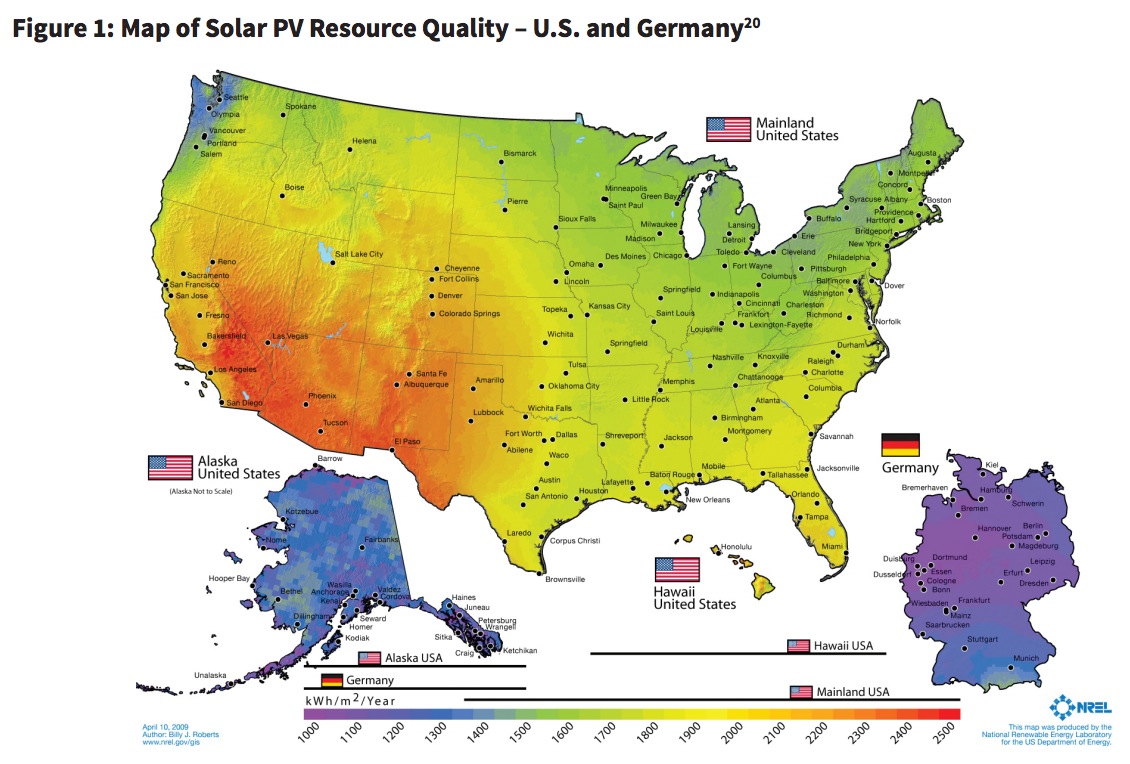STANFORD UNIVERSITY
STEYER-TAYLOR CENTER FOR ENERGY POLICY AND FINANCE
Introduction
The Obama administration has repeatedly identified the large-scale build-out of clean, renewable energy infrastructure as a key priority of the United States. The President’s calls for a cleaner energy economy are often accompanied by references to other industrialized countries such as Germany, the world’s 4th largest economy, hailed by many as a leader in renewable energy deployment and proof of concept. Indeed, the share of renewables in Germany’s electricity generation mix (28% ) is twice that of the United States (14%), and the ambitious „Energiewende“ commits the country to meeting 80% of its electricity needs with renewables by 2050. The German renewables experience, however, is not without its critics. Some praise the country’s “healthy Feed-in Tariff ” and the resulting “proliferation of solar systems” while applauding the German electrical grid as “very reliable and able to withstand high penetration of variable generation.” Others consider it “clear that the transformation, if plausible, will be wrenching” as “German families are being hit by rapidly increasing electricity rates” and “businesses are more and more worried that their energy costs will put them at a disadvantage to competitors in nations with lower energy costs.” The mixed response to Germany’s commitment to solar, wind, and other renewables raises questions as to how much and what, if anything, the United States can learn from Germany’s renewable energy experiment – and vice versa. This paper seeks to answer some of these questions by comparing the German renewables experience to that of California and Texas, two leaders in renewable energy deployment in the United States and globally, albeit with very different policy approaches and political leadership. California, the 8th largest economy in the world, and Texas, the 12th, have had significant success in large-scale renewables but not without their own challenges. Our comparison of the renewable energy paths taken by what amount to three large and highly distinct “countries” elucidates some of the most prominent (and controversial) themes in the transatlantic renewables debate, including electricity costs, policy design, output intermittency, grid stability, and soft costs. We offer comparative insights and best practices regarding renewables to inform policy deliberations from the upcoming Paris climate talks to EPA’s pending Clean Power Plan to the next generation of Renewable Portfolio Standards at the U.S. state level.
…
II. Geography, Economy, Resource Quality, and Cost Characteristics
California is the most populous state in the U.S. with a population of nearly 39 million as of 2014 spread over an area of 155,779 square miles. Home to a population of approximately 27 million, Texas is the second most populous state while covering the largest area of any state in the contiguous U.S. at 261,232 square miles. Smaller in surface area than either California or Texas, Germany covers 137,903 square miles yet is home to over 80 million people. In terms of the size of their economies, Germany ranks 4th among nations globally with a 2014 GDP of $3.73 trillion. California and Texas, if they were independent countries, would rank 8th (2014 GDP of $2.31 trillion) and 12th (2014 GDP of $1.65 trillion) respectively.
Based on average global annual solar irradiance on a horizontal level, the mean solar resource quality of California (178 kWh/ft^2) and Texas (171 kWh/ft2 ) is significantly higher than that of Germany (98 kWh/ft^2 ) (See Figure 1). Remarkably, solar PV installations in Germany have a levelized cost of electricity (LCOE) similar to those observed in California and Texas – despite the country’s significantly poorer solar resource (See Figure 2).a In fact, Germany’s range of LCOE for solar PV (10.4–18.9 $cents/kWh) was only slightly higher than that of the U.S. southwest, including California (9.1–17.6 $cents/kWh) and marginally lower than that of Texas (10.4–19.5 $cents/kWh). At a time when solar panels, inverters, and other hardware trade at similar prices across the globe, Germany’s surprisingly competitive LCOE numbers point to other factors at play than hard costs alone (See infra Section VI.1).
In terms of onshore wind resource quality, California and Texas again beat Germany, albeit by a considerably smaller margin than for solar resource quality. At 80m above ground, average wind speeds at typical onshore wind siting locations are highest in Texas (5–10 m/s), closely followed by California (4–10 m/s) and Germany (4–8 m/s). Compared to their relatively similar onshore wind resource endowment, the spread across the three jurisdictions widens somewhat for LCOE numbers with Texas (5.1–7.4 $cents/ kWh) showing the lowest cost range followed by Germany (5.9–14.2 $cents/kWh) and the U.S. southwest, including California (6.4–9.5 $cents/kWh) (See Figure 3). In light of globally declining hardware prices and related advances in all three jurisdictions, 2013 LCOE numbers no longer accurately reflect today’s cost of generating electricity from solar PV and onshore wind. With more recent LCOE data not yet available for Germany, however, 2013 numbers offer the most up-to-date basis for an apples-to-apples LCOE comparison between all three examined jurisdictions.
About the Steyer-taylor Center For Energy Policy And Finance
law.stanford.edu/steyer-taylor-center-for-energy-policy-and-finance
The Steyer-Taylor Center for Energy Policy & Finance explores and advances public policies and financial mechanisms leading to an energy future that protects the environment in an economically sensible way. Specifically, the center aims to: design and execute a suite of research projects demonstrating how to enable an environmentally and economically secure energy future; advance knowledge and discourse by publishing the results of this research in high-impact articles in both academic and popular media; expand and support the unique intellectual and entrepreneurial talents of Stanford faculty and students committed to energy policy and finance; provide critical expertise to policymakers, financiers, investors and consumers on energy policy and finance proposals.
Tags: California, Germany, PV, Solar Energy, Stanford University, Steyer-Tayler Center for Energy Policy & Finance, Texas, Wind Energy







 RSS Feed
RSS Feed